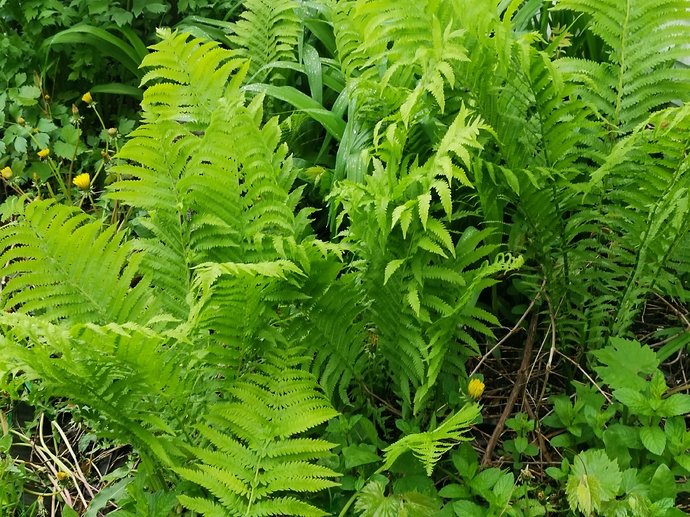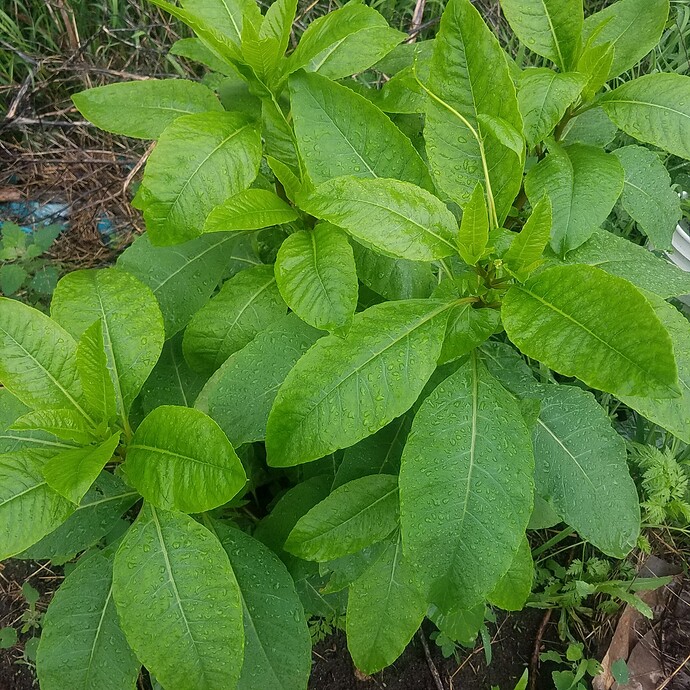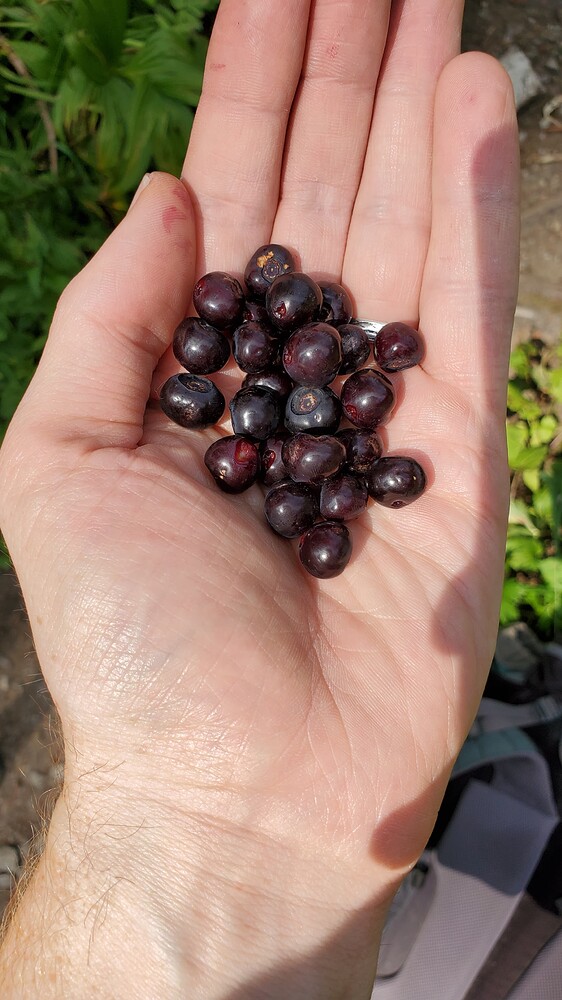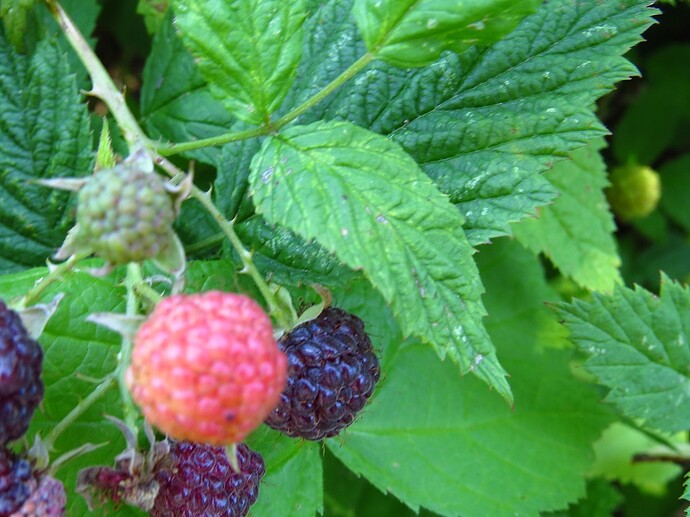When I say clumps I’m talking about large expenses maybe two or three Car lengths along the outside of fences and things like that, I could absolutely be wrong but with the size I’m pretty sure it was actual P nuda…And arbor is like zone six because of Lake Michigan though I’m pretty sure. If it’s knotweed that stuff is a monster
a detail about nuda. In Michigan, the canes will die to the ground in a cold winter and start over next year, but in a warm winter they survive. It is after warm winters that this bamboo makes its best gains in height. Once a new height is obtained, it is never lost.
I picked some false solomon seal to go with steehead trout for the fresh local part of dinner. I pick them every year for the couple of weeks their good! Hard to beat for the tast this early in the season (they’re nice sweat and earthy not bitter like dandilions)
Yam berries… not wild, at least for now! 
picked 3 5 gal. pails of fiddleheads last weekend. awesome sautéed with garlic and bacon. planted 12 ramps in a shaded area under my trees. hopefully they take.
I am scared of those, because I am very allergic to ferns. Do you suppose if I ate one I would be allergic to it too, or just spores?
Those look like Ostrich ferns . Yes the fiddleheads of Ostrich ferns are edible . Those are past eating stage .
i started a patch in my yard but its going to be awhile before they are established enough to harvest from. besides they are sold everywhere here this time of year.
You are lucky.I have never had fresh fiddleheads. I only had the salted and begged one that sold in Japanese or Korean stores
my favorite green by far. this time of year the restaurants in the area make all kinds of dishes with them. one makes a fiddlehead soup which is to die for! i liked them sautéed in olive oil and butter with 3 chopped cloves of garlic. its a perfect side to grilled salmon. 
Dandelions, violets, BlackBerry leafs (and berries of course), wood sorrel, black caps, raspberries, elderberry, hickory nuts, blueberries, mulberries, monarda for Oswego tea, partridge berries, black cherry, spice bush leaves for tea, berries for spice and wild onion.
I use garlic mustard to make pesto. Its not a salad green
my grandmother loved dandelions. she would cook them with salt pork. all the dandelions i pull in the yard go to the chickens. they go nuts for them… i even put a patch of french dandelions I’m growing from seed, near their coop. they grow even bigger / less bitter leaves than our common dandelion. I’m going to harvest and cook some myself to compare to the reg. ones.
Leaving for home after a business trip in san francisco, i didnt cook but wild fennel is incredibly abundant
Wow, Canadian thistle is good for something. Who knew?
Polk is common here in Kansas now but once was impossible to find. Here is some growing in my gardens. This is far past its prime for eating its intended for seed.
Was going to make a thread like this but hey, one already exists!
I love foraging, especially with kids. It’s instant fun. Taps into your hunter-gatherer instincts of looking for treasure in the wild. My experience is based on living in Washington state and British Columbia.
There are a few greens that I’ll go out of my way to collect, and others that I will nibble on if available. Favorite greens:
- Nettles. Delicious green that actually tastes better than most supermarket veggies imho and is super healthy. Main drawback is you can’t eat it raw. Can be found in many areas and usually produces in large quantities. We usually steam it or make tea; cream of nettle soup is also great.
- Burdock stem. Finally tried it this year. You can get a lot of food from a couple large burdock plants. It has a very pleasant firm texture and tastes like mild artichoke. So good. Haven’t tried the roots yet.
- Fiddleheads. Can be a little bitter and it’s a pain to clean off all the hairs, but still a worthwhile spring treat.
For nibbling only: Young oregon grape leaves, young fireweed stems, fresh larch needles, glacier lily or cattail stem base (the white part underground).
Wild fruits - this is a great part of the world for berries. Ranked favorites with some photos:
-
Big huckleberry. Wonderful unique flavor and big juicy fruits. Love them.
-
Wild raspberries. Delicious, look and taste pretty much just like cultivated raspberries but the plant and fruits tend to be a bit smaller.
-
Wild strawberries - maybe tastier than the above, but hard to collect much because they’re so tiny
-
Thimbleberry. Really good. A bit sour but bursting with unique flavor. Hard to collect a decent amount.
-
Blackcap raspberries. Easy to collect in quantity, flavor can be good but often mediocre.
-
Other species of huckleberry which tend to be fairly small and sour.
-
Salmonberry. I’ll snack on these if they’re next to the trail but won’t go out of my way. They are OK but often quite bland and not reliably delicious like thimbleberry. The fruits are multi-hued which is fun.

-
Serviceberry/Saskatoon. These have been getting a lot of hype lately but I tend to find them seedy and lacking flavor. They love the environment around here and produce in massive quantities.
-
Oregon grape. Super sour without an especially unique flavor. I hear they make good jelly. Beautiful plant that can easily be used as an ornamental in the yard.
Low tier / do not eat: Chokecherries. How can anyone eat these things? They are so, so astringent. Maybe the ones in my particular area are worse.
Thanks for your foraging photos and descriptions. ![]()
Chokeberries? Or choke cherries?
Also Mahonia bealeii is not bitter, although mahonia aquafolium may be, if the fruits are ripe.
Bland–yep, agreed on that.







